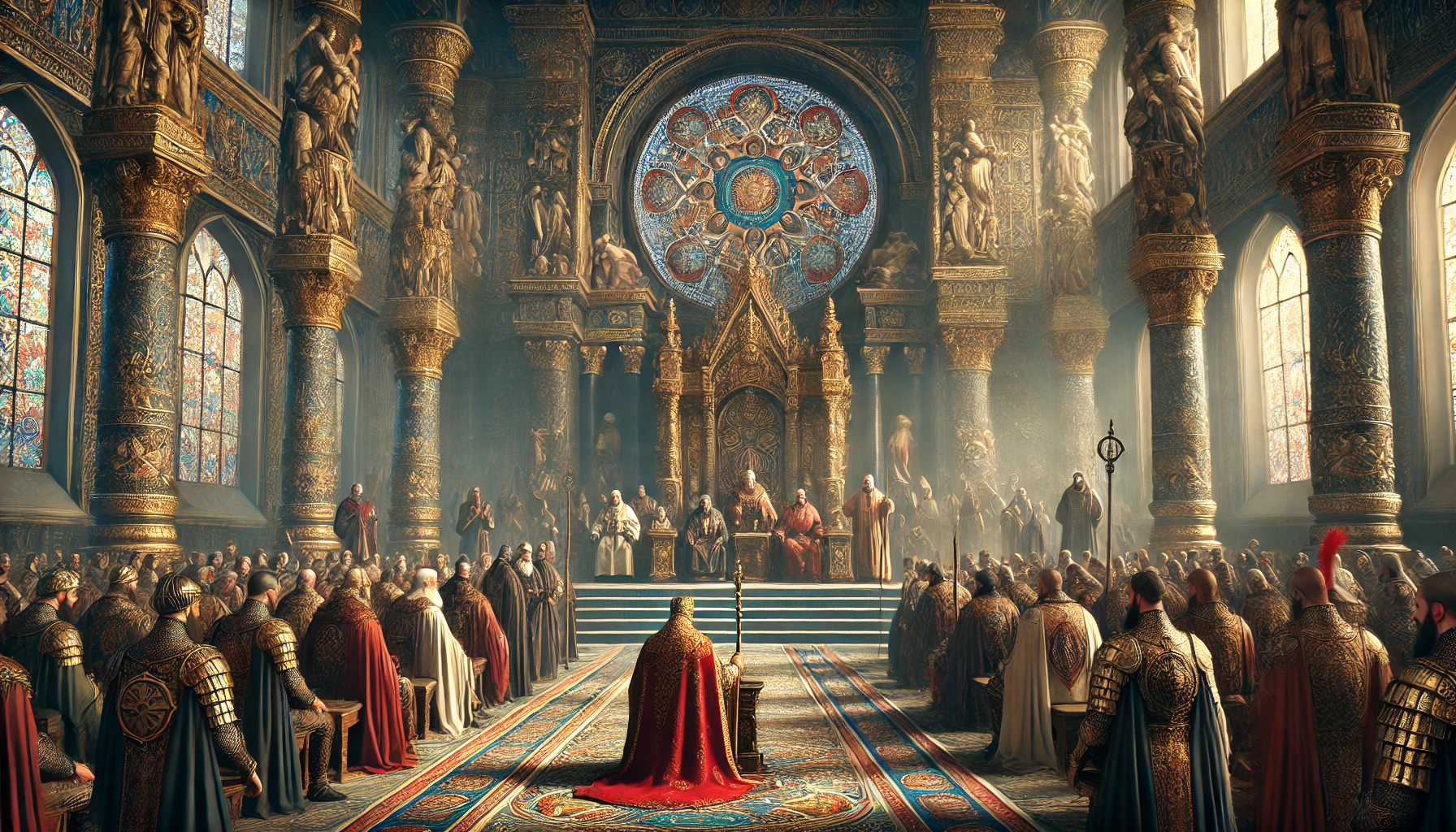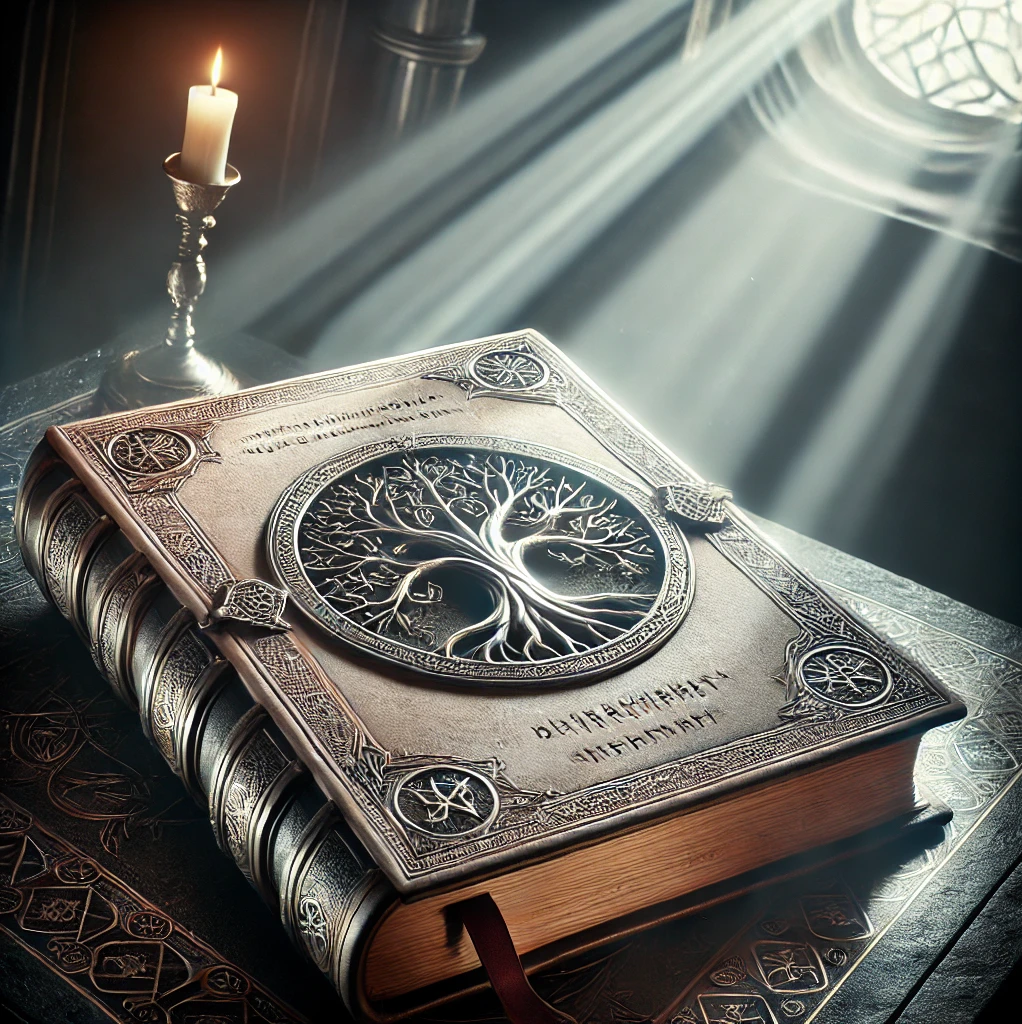Holy Dominion of Daghda
A devotee kneels before the Grand Prelate, receiving rank and blessing, as seen above.
Religious Hierarchy
The establishment of the Holy Dominion of Daghda marked a monumental shift from monarchy to theocratic rule, placing the Church at the epicenter of power. The Church is structured in a strict hierarchical manner. At its apex stands the Grand Prelate—a figure equivalent to a king or emperor, but one who rules with divine authority. Beneath the Grand Prelate are the High Clerics, each responsible for vast territories or significant cities. Priests and Ministers oversee smaller congregations, while Acolytes, the lowest tier, are tasked with carrying out mundane religious duties. These ranks are clearly delineated, and progression through them is slow, requiring both spiritual devotion and political savvy.Church Bureaucracy
To support the daily functions of governance, the Church developed a sophisticated bureaucracy. This administrative arm handles everything from taxation to land distribution. Scribes, record-keepers, and law interpreters form a sprawling network that ensures Church edicts are meticulously documented, updated, and enforced. The bureaucracy acts as the nervous system of the Dominion, ensuring that even the most remote village adheres to the Codex Daghda.The Inquisitorial Force
The Church’s authority is not confined to the pulpit. To enforce its will, it established the Inquisitorial Force—a militant arm responsible for rooting out magic, enforcing religious law, and extinguishing heresy. Given the Kingdom of Riverhold’s historical ties to elves and magic, the Inquisitorial Force was designed from the outset to be formidable, rivaling the standing armies of other nations. Its members are not only rigorously trained in combat but also taught to detect magical influence and signs of subversion. Few escape their attention. Their presence is both feared and revered. Inquisitors often travel in pairs or small retinues, bearing the Ceremonial Brand—a heated iron tool used in rites of purification and consecration. Though officially for marking relics and sanctifying ground, darker rumors persist.Leadership
At the helm of the Church stands Grand Prelate Eamon, a charismatic and iron-willed leader. Eamon’s convictions are absolute: humanity’s salvation lies in the purging of all magic. Under his leadership, persecution of magic users has intensified, with public trials and executions becoming more frequent. Eamon’s leadership casts a long shadow across the Dominion. Trade, diplomacy, and domestic policies all bear his unmistakable imprint. His refusal to reverse decisions, once made, has earned both admiration and quiet dissent. Among his followers, he is seen as the Hand of Daghda incarnate. Among his critics—many of whom must hide their doubts—he is seen as a zealot."To doubt the Codex is to doubt Daghda, and to doubt Daghda is to fall into ruin."
Holy Scriptures
The spiritual cornerstone of the Dominion is The Codex Daghda, a sacred tome that combines ancient human writings from their ancestral lands with more recent revelations said to have been received in the Land of Promise. It extols the supremacy of Daghda—the central deity of the ancient human pantheon—and demonizes magic and elvenkind. The Codex is more than a religious book; it is a comprehensive doctrine guiding every facet of life—from governance and law to farming and child-rearing. Some passages are invoked in daily prayers, others during sentencing in court."In the shadow of Daghda’s light, there is no room for sorcery."
Education and Indoctrination
Controlling the narrative begins with controlling the young. Every school in the Dominion adheres to a curriculum rooted in the Codex Daghda. History is revised to portray the Church as humanity’s savior, and magic as a corrupting force responsible for the world’s past calamities. Children are taught hymns that praise Daghda and condemn arcane practices from their earliest years. Beyond secular subjects, all students must attend religious instruction that emphasizes the dangers of magic and the sanctity of obedience. This process ensures that each generation emerges with an innate distrust of magic and unwavering loyalty to the Church.Conclusion
The Holy Dominion of Daghda is more than a governing body—it is a vast, ideologically driven machine reshaping the essence of human civilization. Its goal is nothing short of a spiritual rebirth, severing ties to a magical past and forging a future rooted in divine order. It is an era of fervor, fear, and faith. Of grand temples and hidden whispers. Of holy fire and silent rebellion. An era where a single verse in the Codex can change a life—or end one.The Codex Daghda
More than scripture, it is the cornerstone of the Dominion. Said to be written with divine guidance, its words shape law, dictate justice, and inspire both devotion and dread. Codex Daghda, Chapter XVII — “On the Preparation of Sustenance”“Let no hand mix grain with water but in the hour after first light, for Daghda’s gaze is strongest in the morning. Let the flour be ground with prayer, and the salt measured by a Minister’s eye. No leaven shall rise unless blessed by one ordained. And should any woman bake in silence, she bakes in defiance.” “The oven must be stone, and kindled with flame drawn from the Hearth of Order. Let none eat before reciting the Fifth Blessing of the Harvest. Thus shall bread nourish both body and soul, lest the act become selfish and unclean.”
Cleansing of Lionhill
In the southern reaches of the Dominion, the village of Lionhill was rumored to harbor a secret druid enclave. When the Inquisitorial Force arrived, they gave no warning and offered no trials. Fields were set ablaze with oil-soaked torches, homes smashed with blessed sledgehammers, and the villagers herded into the central square under the watchful eye of High Inquisitor Caelis. As the smoke thickened and flames consumed the harvest, Caelis turned to the assembled crowd and declared:“If you wish to sow seeds of heresy, know that only ash will take root.”No druid was ever found, but the village was razed regardless. The soil in Lionhill remains black to this day, and the site is now known as Ashenfall—a silent warning to any who might shelter the arcane.



Comments